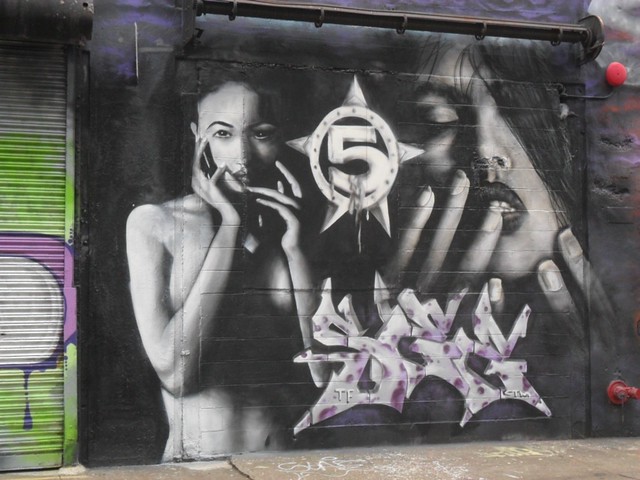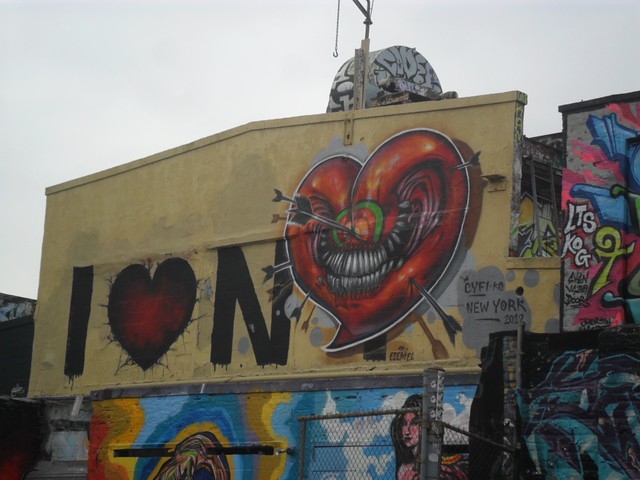And now, the thrilling conclusion to
Gowanus Houses and Wyckoff Gardens: Neighborhood Anchors. Thanks for reading; hope you liked it. Will return to our regularly scheduled program shortly.
Signs of Hope
A funny thing happened in the neighborhood. Like the rest of the city, it became safer than it had been in the 70’s, 80’s and 90’s, and as noted earlier, property values rose, including in areas in close proximity to the housing developments. In Boerum Hill’s case, the New York Times directly addressed the phenomenon in 2011 in an article about real estate on Warren Street between Nevins Street, where the Wyckoff Gardens lies, and Bond Street, where the Gowanus Houses preside.
While noting that the public housing projects are to many New Yorkers “enduring symbols of danger, social dysfunction and blight,” the author also states that “the presence of the Gowanus Houses, a 1,134 unit development on the west end o the block, and Wyckoff Gardens, 528 apartments on the east end, does not seem to put much of a
damper on values.
 |
121 Wyckoff Street, almost across the street from
the Gowanus Houses |
Indeed, the article goes on to cite a four-family townhouse on the block that had been put on the market for $2.5 million, which at $658 per square foot is only $35 per square foot less than a comparable property on Bergen Street, two blocks north of the projects.
Joan Joseph-Alexander, a broker in the area, speculates that “When the market is down, the projects are a factor. When it is up, the projects aren’t a factor;” her assertion is born out by a study by the Furman Center for Real Estate and Urban Policy at New York found that concluded that federally subsidized housing in New York did not typically depress values within a four-block radius.
Forget about four-block radius; in Boerum Hill, there is a million dollar condominium at 121 Wyckoff Street that has an unobstructed view of the Gowanus Houses from across the intersection at Bond Street, and the aforementioned $2.5 million townhouse is one block in either direction from two developments. Whatever issues they may have, their influence on the surrounding neighborhood is at the very least neutral.
I would argue that, as Bloom notes, it is management of the projects that is the reason for this, in spite of the aforementioned negative press. As he notes:
Good management also [means] arresting criminals, controlling tenancy, and collecting rents. Vigilance also means keeping patronage to a minimum, holding employees and tenants responsible for their behavior, seeking private sector help where necessary, and using politics to build and protect housing rather than destroy it. NYCHA’s success, and continuing effectiveness, should in no way be considered inevitable.
The results of this watchfulness are evident today. During my visits to the many NYCHA housing developments in every borough, I have found well-maintained brick buildings, mature plane trees and green lawns, active community and recreation programs, and first class play equipment.
Bloom does not dismiss the issues that public housing projects face, noting that many NYCHA developments house a high percentage of very poor tenants, in poor sections of the city, and are subject to graffiti, dumping, public urination and general vandalism. He also notes that small apartments, hallways of glazed tile and steel, and slow elevators are unfortunate facets of many buildings, making them less than ideal in many resident’s minds.
But although they may stand out from the rest of the three, four and five story brownstone buildings that make up the bulk of the neighborhood, Gowanus Houses and Wyckoff Gardens are not in poor physical shape. In tune with Bloom’s observation, both are blessed with an abundance of mature trees, shrubbery, community gardens, and playground facilities.
 |
| "Roots and Wings," on the northern side of the Wyckoff Gardens |
The Gowanus Houses’ northern most playground, in a New York City park named for Nicholas Heyward Jr. on Wyckoff Street, was completely refurbished in 2011. Over at the Wyckoff Gardens, the community center on Wyckoff Street has been graced by a 30 by 45 foot mural “Roots and Wings,” by artist Amy Sananman since 2005, thanks to the ground Groundswell. Groundswell likewise organized a mural memorializing Heyward Jr. on a building just west of the Gowanus Houses.
Interestingly, it is not common, in my estimation, to see many people walking the grounds of the developments. Some of this may stem from the fact that, as noted earlier, there is a stigma attached to public housing in New York. Sensationalistic reporting in local papers doesn’t help either, like a
2011 story in the Brooklyn Paper about a group of teenagers who were terrorizing local residents around Halloween. It’s a given in the story that the developments are the source of crime in the neighborhood:
 |
| Groundswell's mural honoring Nicholas Heyward Jr. |
Cops are investigating, but assaults like this are not uncommon in Boerum Hill, where historic multi-million dollar brownstones are cushioned between the Wyckoff and Gowanus housing projects and there are cavernous gaps in the neighborhood’s median income level — from $23,900 to more than $108,000, according to the 2010 census.
With stories like this in the backs of their minds, it’s not surprising that residents might steer choose to walk an extra block out of their way to avoid crossing the “super blocks” of the developments. Compounding the problem, New Yorkers intuitively know that a populated area is a safer area, so when they see paths devoid of activity, they steer clear. From personal experience, I can say there is nothing dangerous about walking in the midst of the Gowanus Houses; I did so with my year-old daughter less than a month ago.
Ironically, the landscaping of the NYCHA developments was meant to be a gift of sorts to the surrounding neighborhood. Bloom notes that former NYCHA chairman Alfred Rheinstein’s embraced “economized buildings” that featured things like elevators that only stopped on every other floor, but when it came to landscaping,
“He believed that the pleasant grounds of public housing could help reconcile those resentful citizens not lucky enough to gain access to housing projects if ‘certain benefits such as playgrounds, nurseries, assembly rooms and other recreational facilities were available to the entire neighborhood. Futhermore, ‘The landscaped uncrowded area should
ventilate the neighborhood.
 |
| Brand new playground equipment at the Gowanus Houses |
It takes more than just nicely trimmed shrubbery and trees to make a development a success though. It’s difficult to ascertain just how much crime the residents of the Gowanus Houses and the Wyckoff Gardens contribute to Boerum Hill, because a quirk of geography has the Gowanus Houses in the NYPD’s 76th precinct, while Wyckoff Gardens is in the 78th precinct. The bulk of Boerum of Hill, meanwhile, is in the 84th precinct, which encompasses all of downtown Brooklyn, tony Brooklyn Heights and DUMBO. But as Bloom notes, unlike public housing failures like Pruitt Igoe in St. Louis and Henry Horner Houses in Chicago, NYCHA fought to keep it a place for the middle class, as well as the poor.
NYCHA’s boom years were better than in other cities because its projects were better built, the tenants more carefully selected, and the buildings better managed than those in other cities. In most American cities, public housing was not only poorly constructed and maintained but became the housing of last resort for those displaced for urban renewal.
This is borne out both at Gowanus Houses and the Wyckoff Gardens in community activities of the past, such as a softball league that pitted members of different housing developments against each other in the 1970’s, including teams fielded by union members. (From “Gowanus Houses softball champs best 237 executive board, staff,” 237 Teamster New and Views, December 1971)
-->
It is exemplified today in groups like the Gowanus Wildcats Drill Team, an all female drill team that has been performing stepping, marching and “cheerleading without pompoms” since 1970. Renee Flowers, a second generation resident whose parents Leslie and Victoria Baskett were among the first families to move into the Gowanus Houses, has run the club since 1972; today it counts 24 members ranging from 6 to 21 years of age.
Flowers has been credited with training 500 girls over the years, and some have even performed at the Apollo Theater. In recounting life in one of the developments 14-story towers, Flowers strikes an optimistic view of what is becoming a island within a quickly gentrifying neighborhood.
“The families still stick together, she said. One thing about Gowanus Houses, there’s no problem going up to parents and telling them if a kid seems to be in trouble. In that way, it’s like the old days.
It really does take a village.”
None of this is to suggest that the Gowanus Houses and Wyckoff Gardens do not have their issues. In the same story, Flowers is said to have posted fliers in the hallway of her building imploring residents not to dump trash in the elevators. This was in 2010, which suggests that many of the issues that Bloom noted are present there too.
Conclusion
Although they engender feelings of ambivalence among many residents and physically stand apart from the rest of Boerum Hill, the Gowanus Houses and Wyckoff Gardens do not materially affect the neighborhood in a negative way. Their designs lend themselves in many ways to isolation, but as noted earlier, neither these designs, which reflect the different time periods they were built, nor the developments’ association with crime, have affected the values of housing around them. In fact, gentrification of Boerum Hill, like many parts of Brooklyn, began in earnest in the late 60’s, and has continued unabated ever since.
 |
Rendering of Gowanus Houses Community Center
Photo courtesy of NYCA |
Unlike in places such as Chicago and St. Louis, public housing in New York City remained in high demand from its inception, and will continue to be so for the future. And although NYCHA has recently begun to float a plan to sell off land within eight developments in Manhattan to private developers, neither of Boerum Hill’s public housing developments has been included in the plans.
And while the fact that developers are willing to entertain building private market rate buildings in the midst of public housing shows how much the stigma behind “projects” has faded, residents of the Gowanus Houses and Wyckoff Gardens might be troubled to hear how their Manhattan brethren are reacting. NYCHA needs to make up a budget shortfall that has gotten worse over the years, as nearly $1.5 billion in federal funds have been cut since 2001.
“You’re not going to have people who are paying market rent to want to live in the same place as low-income people,” said Thelma R. Yearwood, the residents’ president at Meltzer Tower, a building for elderly people on the Lower East Side that is to lose its only park under the plan. “They’ll find a way to transfer people out of here.”
Unfortunately, if Boerum Hill continues on its upward trajectory, and NYCHA does not find a way to meet its financial obligations, this is a sentiment Gowanus Houses and Wyckoff Gardens residents may find themselves sharing. I for one, hope it does not come to that.
 |
| The Gowanus Houses Community Center today |



















































